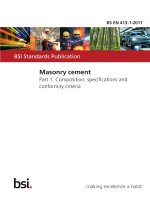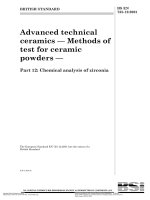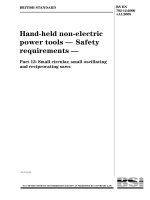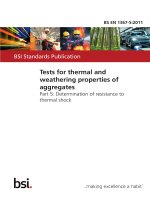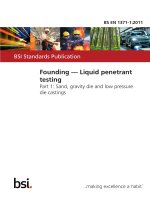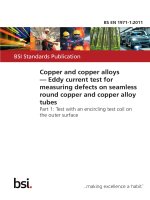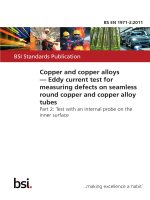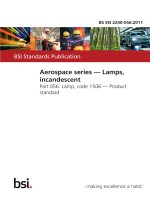Bsi bs en 62047 12 2011
Bạn đang xem bản rút gọn của tài liệu. Xem và tải ngay bản đầy đủ của tài liệu tại đây (1.32 MB, 34 trang )
BS EN 62047-12:2011
BSI Standards Publication
Semiconductor devices —
Micro-electromechanical
devices
Part 12: Bending fatigue testing method
of thin film materials using resonant vibration
of MEMS structures
BRITISH STANDARD
BS EN 62047-12:2011
National foreword
This British Standard is the UK implementation of EN 62047-12:2011. It is
identical to IEC 62047-12:2011.
The UK participation in its preparation was entrusted to Technical Committee
EPL/47, Semiconductors.
A list of organizations represented on this committee can be obtained on
request to its secretary.
This publication does not purport to include all the necessary provisions of a
contract. Users are responsible for its correct application.
© BSI 2011
ISBN 978 0 580 76301 4
ICS 31.080.99
Compliance with a British Standard cannot confer immunity from
legal obligations.
This British Standard was published under the authority of the Standards
Policy and Strategy Committee on 30 November 2011.
Amendments issued since publication
Amd. No.
Date
Text affected
BS EN 62047-12:2011
EUROPEAN STANDARD
EN 62047-12
NORME EUROPÉENNE
October 2011
EUROPÄISCHE NORM
ICS 31.080.99
English version
Semiconductor devices Micro-electromechanical devices Part 12: Bending fatigue testing method of thin film materials using
resonant vibration of MEMS structures
(IEC 62047-12:2011)
Dispositifs à semiconducteurs Dispositifs microélectromécaniques Partie 12: Méthode d'essai de fatigue en
flexion des matériaux en couche mince
utilisant les vibrations à la résonance des
structures à systèmes
microélectromécaniques (MEMS)
(CEI 62047-12:2011)
Halbleiterbauelemente Bauelemente der Mikrosystemtechnik Teil 12: Verfahren zur Prüfung der BiegeErmüdungsfestigkeit von
Dünnschichtwerkstoffen unter
Verwendung der Resonanzschwingungen
bei MEMS-Strukturen
(IEC 62047-12:2011)
This European Standard was approved by CENELEC on 2011-10-18. CENELEC members are bound to comply
with the CEN/CENELEC Internal Regulations which stipulate the conditions for giving this European Standard
the status of a national standard without any alteration.
Up-to-date lists and bibliographical references concerning such national standards may be obtained on
application to the CEN-CENELEC Management Centre or to any CENELEC member.
This European Standard exists in three official versions (English, French, German). A version in any other
language made by translation under the responsibility of a CENELEC member into its own language and notified
to the CEN-CENELEC Management Centre has the same status as the official versions.
CENELEC members are the national electrotechnical committees of Austria, Belgium, Bulgaria, Croatia, Cyprus,
the Czech Republic, Denmark, Estonia, Finland, France, Germany, Greece, Hungary, Iceland, Ireland, Italy,
Latvia, Lithuania, Luxembourg, Malta, the Netherlands, Norway, Poland, Portugal, Romania, Slovakia, Slovenia,
Spain, Sweden, Switzerland and the United Kingdom.
CENELEC
European Committee for Electrotechnical Standardization
Comité Européen de Normalisation Electrotechnique
Europäisches Komitee für Elektrotechnische Normung
Management Centre: Avenue Marnix 17, B - 1000 Brussels
© 2011 CENELEC -
All rights of exploitation in any form and by any means reserved worldwide for CENELEC members.
Ref. No. EN 62047-12:2011 E
BS EN 62047-12:2011
EN 62047-12:2011
-2-
Foreword
The text of document 47F/80/FDIS, future edition 1 of IEC 62047-12, prepared by SC 47F, "Microelectromechanical systems", of IEC TC 47, "Semiconductor device", was submitted to the IEC-CENELEC
parallel vote and approved by CENELEC as EN 62047-12:2011.
The following dates are fixed:
•
•
latest date by which the document has
to be implemented at national level by
publication of an identical national
standard or by endorsement
latest date by which the national
standards conflicting with the
document have to be withdrawn
(dop)
2012-07-18
(dow)
2014-10-18
Attention is drawn to the possibility that some of the elements of this document may be the subject of
patent rights. CENELEC [and/or CEN] shall not be held responsible for identifying any or all such patent
rights.
Endorsement notice
The text of the International Standard IEC 62047-12:2011 was approved by CENELEC as a European
Standard without any modification.
In the official version, for Bibliography, the following note has to be added for the standard indicated:
IEC 62047-2:2006
NOTE Harmonized as EN 62047-2:2006 (not modified).
BS EN 62047-12:2011
EN 62047-12:2011
-3-
Annex ZA
(normative)
Normative references to international publications
with their corresponding European publications
The following referenced documents are indispensable for the application of this document. For dated
references, only the edition cited applies. For undated references, the latest edition of the referenced
document (including any amendments) applies.
NOTE When an international publication has been modified by common modifications, indicated by (mod), the relevant EN/HD
applies.
Publication
Year
Title
EN/HD
Year
IEC 62047-3
2006
Semiconductor devices - Microelectromechanical devices Part 3: Thin film standard test piece for
tensile-testing
EN 62047-3
2006
ISO 12107
-
Metallic materials - Fatigue testing - Statistical planning and analysis of data
-
–2–
BS EN 62047-12:2011
62047-12 IEC:2011
CONTENTS
1
Scope ............................................................................................................................... 6
2
Normative references ....................................................................................................... 6
3
Terms and definitions ....................................................................................................... 6
4
Test equipment ................................................................................................................. 7
5
4.1 General ................................................................................................................... 7
4.2 Actuator .................................................................................................................. 8
4.3 Sensor .................................................................................................................... 8
4.4 Controller ................................................................................................................ 8
4.5 Recorder ................................................................................................................. 9
4.6 Parallel testing ........................................................................................................ 9
Specimen ......................................................................................................................... 9
6
5.1
5.2
5.3
5.4
Test
7
6.1 Test amplitude......................................................................................................... 9
6.2 Load ratio .............................................................................................................. 10
6.3 Vibration frequency ............................................................................................... 10
6.4 Waveform .............................................................................................................. 10
6.5 Test time ............................................................................................................... 10
6.6 Test environment................................................................................................... 10
Initial measurement ........................................................................................................ 10
8
7.1 Reference strength measurement .......................................................................... 10
7.2 Frequency response test ....................................................................................... 11
Test ................................................................................................................................ 11
9
8.1
8.2
8.3
8.4
8.5
8.6
Test
General ................................................................................................................... 9
Resonant properties ................................................................................................ 9
Test part.................................................................................................................. 9
Specimen fabrication ............................................................................................... 9
conditions ................................................................................................................. 9
General ................................................................................................................. 11
Initial load application ............................................................................................ 11
Monitoring ............................................................................................................. 12
Counting the number of cycles .............................................................................. 12
End of the test ....................................................................................................... 12
Recorded data ....................................................................................................... 12
report...................................................................................................................... 12
Annex A (informative) Example of testing using an electrostatic device with an
integrated actuation component and displacement detection component ............................... 14
Annex B (informative) Example of testing using an external drive and a device with an
integrated strain gauge for detecting displacement ............................................................... 17
Annex C (informative) Example of electromagnetic drive out-of-plane vibration test
(external drive vibration test) ................................................................................................ 20
Annex D (informative) Theoretical expression on fatigue life of brittle materials based
on Paris’ law and Weibull distribution .................................................................................... 23
Annex E (informative) Analysis examples............................................................................. 27
Bibliography .......................................................................................................................... 29
BS EN 62047-12:2011
62047-12 IEC:2011
–3–
Figure 1 – Block diagram of the test method ........................................................................... 7
Figure A.1 – Microscope image of the specimen ................................................................... 14
Figure A.2 – Block diagram of test equipment ....................................................................... 15
Figure B.1 – The specimens’ structure .................................................................................. 17
Figure B.2 – Block diagram of test equipment ....................................................................... 18
Figure C.1 – Specimen for out-of-plane vibration testing ....................................................... 20
Figure C.2 – Block diagram of test equipment ....................................................................... 21
Figure E.1 – Example of fatigue test results for silicon materials ........................................... 27
Figure E.2 – Static strength and fatigue life of polysilicon plotted in 3D ................................. 28
–6–
BS EN 62047-12:2011
62047-12 IEC:2011
SEMICONDUCTOR DEVICES –
MICRO-ELECTROMECHANICAL DEVICES –
Part 12: Bending fatigue testing method of thin film materials
using resonant vibration of MEMS structures
1
Scope
This part of IEC 62047 specifies a method for bending fatigue testing using resonant vibration
of microscale mechanical structures of MEMS (micro-electromechanical systems) and
micromachines. This standard applies to vibrating structures ranging in size from 10 µm to
1 000 µm in the plane direction and from 1 µm to 100 µm in thickness, and test materials
measuring under 1 mm in length, under 1 mm in width, and between 0,1 µm and 10 µm in
thickness.
The main structural materials for MEMS, micromachine, etc. have special features, such as
typical dimensions of a few microns, material fabrication by deposition, and test piece
fabrication by means of non-mechanical machining, including photolithography. The MEMS
structures often have higher fundamental resonant frequency and higher strength than macro
structures. To evaluate and assure the lifetime of MEMS structures, a fatigue testing method
12
with ultra high cycles (up to 10 ) loadings needs to be established. The object of the test
method is to evaluate the mechanical fatigue properties of microscale materials in a short
time by applying high load and high cyclic frequency bending stress using resonant vibration.
2
Normative references
The following referenced documents are indispensable for the application of this document.
For dated references, only the edition cited applies. For undated references, the latest edition
of the referenced document (including any amendments) applies.
IEC 62047-3:2006, Semiconductor devices – Micro-electromechanical devices – Part 3: Thin
film standard test piece for tensile testing
ISO 12107, Metallic materials – Fatigue testing – Statistical planning and analysis of data
3
Terms and definitions
For the purposes of this document the following terms and definitions apply
3.1
amplitude
one-half the algebraic difference between the maximum value and minimum value in a loading
cycle
3.2
load ratio
algebraic ratio of the maximum value and minimum value of the load of a cycle
3.3
S-N curve
plot of stress or strain (S) against the number of cycles (N) to failure
BS EN 62047-12:2011
62047-12 IEC:2011
–7–
3.4
reference strength:
static strength or instantaneous failure strength
3.5
instantaneous failure strength
failure strength of quasi-static test or resonant vibration test at rapid amplitude growth
2
1
7
3
8
5
4
9
6
IEC
2064/11
Key
1
Specimen
2
Test part
3
Actuator
4
Sensor
5
Controller
6
Recorder
7
Force
8
Displacement or strain
9
Amplitude and frequency
Figure 1 – Block diagram of the test method
4
4.1
Test equipment
General
The test equipment shall be capable of generating resonant vibration with constant amplitude
and stable frequency to the test structure. A block diagram of the test equipment is shown in
Figure 1. The test equipment consists of an actuator for oscillation, a sensor for amplitude
detection, a controller for maintaining the resonant vibration at a constant amplitude, and a
recorder for monitoring.
The amplitude control method is classified as follows.
a)
Constant strain control
Applied strain in the test part is maintained at constant. It can be applied for elastic or
inductile materials.
–8–
b)
BS EN 62047-12:2011
62047-12 IEC:2011
Constant stress control
Applied stress in the test part is maintained at constant. Load monitoring and closed loop
control is crucial for the method.
4.2
Actuator
The actuator shall be capable of applying oscillation force of the necessary amplitude and
frequencies along the required direction. Various kind of actuators can be used, e.g.,
electrostatic, piezoelectric, thermal, and electromagnetic actuators. The actuator may be
installed in the test structure, as discussed in 5.1.
4.3
Sensor
The sensor shall be capable of measuring the movement of the specimen to determine the
stress amplitude (for constant stress amplitude testing) or the strain amplitude (for constant
strain amplitude testing) to the test part of the specimen.
The sensor and its associated electronics shall be accurate to within 1 % of the range of the
stress or strain amplitude.
The sensor should measure the movement continuously, in order to maintain a constant
vibration and detect failure effectively. If the specimen is an elastic material and will not show
the change in the vibrating properties, however, it is permissible to measure the movement at
regular time intervals.
The movement is detected by measuring displacement of the test structure or the stress or
strain in the test structure. Clause A.2 shows a method for detecting rotational displacement
of the mass from changes in capacitance. Clause B.2 shows a method using a strain gauge
integrated in the specimen. Clause C.2 shows a method for detecting displacement of the
mass using a non-contact displacement gauge.
4.4
Controller
The controller shall be capable of generating the oscillation signal to the actuator from the
movement signal from the sensor, in order to maintain the required resonant vibration. During
testing, the amplitude and frequency of the specimen shall be maintained at a constant level.
One of the following methods should be applied for the specimen, depending on the vibration
characteristics.
a) Closed loop method
The frequency and amplitude of the oscillation signal applied to the specimen shall be
controlled to follow changes in the resonant frequency. In most cases, the signal applied to
the actuator is generated from the movement signal of the specimen. A self-excited oscillation
circuit or phase-locked loop circuit can be used as a means for maintaining the resonant
frequency. An automatic gain control circuit (AGC) can also be used to maintain a constant
amplitude by changing the amplitude of the oscillation signal based on the detected amplitude.
b) Open loop method
Elastic or inductile materials that show a linear response but no plastic deformation may be
tested using an open loop method. This test may be performed by stopping at regular
intervals and measuring the resonant characteristics, or by actuating the test structure from
the start to the end of testing at a predetermined resonance frequency and oscillation signal
amplitude.
The stability of the frequency and amplitude shall be maintained throughout the test to within
± 3 % of the desired value.
BS EN 62047-12:2011
62047-12 IEC:2011
4.5
–9–
Recorder
The test equipment shall include a recorder for collecting the “record data” indicated in 8.6.
4.6
Parallel testing
The test may be conducted in parallel with a number of equipment units. In this case, steps
should be taken to eliminate mutual electrical or mechanical interference among the
equipment units.
5
5.1
Specimen
General
The specimen shall be capable of applying a constant and high-load amplitude to the test part
via resonant vibration. Examples of specific structures are shown in the Clauses A.1, B.1, and
C.1.
It is permissible to integrate a mechanism in the specimen for actuating or for sensing the
movement of the specimen. An example of a structure integrating mechanisms for actuation
and detecting amplitude is shown in Annex A.1. An example of a structure integrating a
mechanism for detecting amplitude only is shown in Annex B.1.
5.2
Resonant properties
The specimen shall have resonance characteristics that enable the application of the required
deformation (mode of vibration) in the specific frequency (resonance frequency) of the
specimen. The resonant frequency should preferably be more than 1 000 Hz, in order to
obtain a large number of the cycles in a short time. The quality factor of the specimen should
be more than 100, in order to obtain a large amplitude. Steps should be taken to ensure,
within this resonance frequency, that the specimen will not vibrate in a vibration mode
different from that used in the test. For example, there should be no other resonant modes
close to the mode used for testing.
5.3
Test part
The specimen shall have a test part in which stress sufficient to induce failure occurs. When
the test is performed to evaluate the reliability of the actual device, the deformation in the test
part at resonant vibration (in-plane and out-of-plane bending) shall be the same as that of the
actual device. If only low stress can be applied to a structure similar to the actual device, a
notch or another means may be introduced to concentrate the stress in the targeted section of
the test part.
5.4
Specimen fabrication
Refer to Clause 5 of IEC 62047-3 when manufacturing the test part of the specimen. The
specimen should be fabricated by the same method as the target MEMS device for reliability
evaluation is fabricated. Furthermore, the same shapes, dimensions, and multilayer film
structures should be used.
6
6.1
Test conditions
Test amplitude
The test amplitude should be specified from the appropriate reference strength of the
specimen. The reference strength should be determined through the methods in 7.1. One of
the following procedures should be chosen for determining the test amplitude during testing,
based on the reference strength.
– 10 –
BS EN 62047-12:2011
62047-12 IEC:2011
a) Constant amplitude of 100 % of the reference strength:
to evaluate the fatigue life at a certain amplitude.
b) Decrease the amplitude gradually from a high level:
for obtaining an S-N curve in a short time.
c) Increase the amplitude gradually from a low level:
for obtaining an S-N curve when the number of test parts is limited.
As a reference for determining the test amplitude, example of experimental data and analysis
of fatigue testing for silicon are shown in Annex D. For details on the testing of metal
materials, refer to ISO 12107.
The decrease and increase step of the test amplitude for the procedures b) and c) should be
selected preferably close to the standard deviation of measured reference strength.
6.2
Load ratio
The load ratio of the test method can be taken to be -1, as the quality factor (Q) of the
resonant vibration is high enough (10 or more) to achieve an amplitude too high to apply by
(quasi-)static testing methods.
6.3
Vibration frequency
The frequency shall be the resonant mode at which the test part is in the required stress state
specified in 5.3, or a frequency close to it.
6.4
Waveform
The waveform of the displacement of the specimen and the stress and strain of the test part
can be regarded as sinusoidal, irrespective of the actuating waveform
6.5
Test time
The test time shall be specified as the time at which the test ends, even if the specimen has
not failed by that time. The test time can be determined as the number of the test cycles,
based on the vibration frequency. For tests conducted on materials with lifetime
characteristics which are frequency-independent, such as silicon, the test cycles are chosen
as the stress cycles applied on the actual devices in their lifetimes. See Annex D.
6.6
Test environment
The test environment should be maintained at a constant temperature and humidity.
7
7.1
Initial measurement
Reference strength measurement
The reference strength shall be measured prior to the fatigue test. Specimens used for
measurement of the reference strength should be made of the same materials, and by the
same processes, as the test part to be tested. Care shall be taken when using a specimen of
a different shape. If such a specimen is used, it should show the same failure mode, and the
size effect on the measured strength should be considered.
The reference strength should be determined using one of the following tests.
a) Quasi-static test
BS EN 62047-12:2011
62047-12 IEC:2011
– 11 –
The failure strength measured by conducting quasi-static testing is set as the reference
strength.
b) Instantaneous fatigue test
The maximum amplitude in the instantaneous fatigue test is set as the reference strength. In
this test, the amplitude is rapidly increased up to the point of specimen failure by the same
method used for the fatigue test. This method may be chosen when it is difficult to use a
specimen of a different shape, or when it is difficult to apply a static load.
c) Stress analysis
The reference strength is determined using either simulation or theoretical analysis. This
method can be chosen when a reference strength is difficult to determine experimentally. The
amplitude at which the maximum stress in the specimen reaches the failure strength is set as
the reference strength. The failure strength can be taken from published papers or other
available data. The reported strength should be chosen carefully, as some materials have
size effect in failure strength and environmental effects under variable temperatures, humidity
levels, and so on. It is thus desirable to refer to the strength values in the literature in order to
keep conditions as close as possible to those in the life test to be conducted.
Given the large variation in the strength of brittle materials such as single crystal silicon, it is
preferable to obtain strength data for no less than 10 specimens when measuring the
reference strength experimentally, and to adopt a statistically processed value (for example,
50 % failure stress from Weibull analysis or an arithmetical average) as the reference for
stress or strain in the resonant oscillation test.
7.2
Frequency response test
The resonant properties of the specimens shall be measured prior to the fatigue test. When
the resonant properties vary among specimens and the controller needs tuning, the resonant
properties of all of the specimens should be measured.
The frequency response test is used to measure the resonant properties. The oscillation
signal is applied from a function generator and the frequency of the signal is swept around the
expected resonant properties to find the actual resonant frequency. The load applied in this
response test shall be small enough to ensure that the measurements for the fatigue test are
unaffected. If the effect cannot be ignored, the number of load cycles applied in this response
test should preferably be added to the fatigue test data.
8
8.1
Test
General
The fatigue test shall be conducted by applying resonant oscillation at the predetermined
oscillation amplitude to the specimen. The test ends when the specimen fails or the
predetermined test time is reached.
8.2
Initial load application
The increasing rate of the amplitude should be specified properly at the start of the fatigue
test. Because the test is conducted in resonance and the quality factor is high, the amplitude
cannot reach the test amplitude without delay. If the amplitude increases too rapidly, it can
result in an overshooting of the amplitude and unexpected failure at the start of the test. If, on
the other hand, too much time is allowed for the increase in amplitude, the test result can be
affected. The initial load applied in these procedures should be carefully controlled to ensure
that measurement results of the lifetime test are unaffected. When some effect is conceivable,
the procedures for increasing the amplitude should be described in the test report.
– 12 –
8.3
BS EN 62047-12:2011
62047-12 IEC:2011
Monitoring
The vibration of the specimen shall be monitored continuously during the test to detect the
specimen failure. One method for this test monitoring is to monitor the vibration frequency
and/or amplitude. It is also desirable to record the changes in the vibration frequency and
amplitude at proper time intervals. If the system lacks a monitoring function, the specimen
may be monitored by stopping the fatigue test at certain intervals of time and conducting the
frequency response test in 7.2.
8.4
Counting the number of cycles
The number of cycles of the fatigue test shall be counted using a counter. Alternatively, the
cycles may be calculated by multiplying the vibration frequency by the time from the start of
testing.
8.5
End of the test
The test shall end at the point of specimen failure, or when a predetermined loading time or a
predetermined number of cycles has elapsed.
Specimen failure is defined as the following:
a) fracture of the test part;
b) a certain percentage change in the amplitude;
c) a certain change in the oscillating frequency.
8.6
Recorded data
The failure of the specimen shall be recorded. The oscillation amplitude and frequency of the
specimen and the temperature and humidity of the testing environment should be measured at
certain intervals of time during the test.
9
Test report
The test report shall include the following information.
•
Mandatory
a) reference to this International Standard, i.e. IEC 62047-12
b) test piece material
−
in the case of a single crystal: crystallographic orientation
c) method and details of test piece fabrication
−
method of thin film deposition
−
fabrication processes
−
heat treatment (annealing) conditions
d) shape and dimensions of test piece
e) test equipment
−
oscillation method (self-oscillation, external oscillation)
−
initial load application method
−
amplitude control method
−
test monitoring method (amplitude, frequency, number)
BS EN 62047-12:2011
62047-12 IEC:2011
f)
– 13 –
fatigue test conditions
−
reference strength, and its measurement method
−
mean stress (in the case of displacement control, mean displacement)
−
stress amplitude (in the case of displacement control, displacement amplitude)
−
load ratio
−
testing environment (temperature and relative humidity)
−
wave form (sinusoidal)
−
frequency
g) fatigue test result
•
−
number of samples
−
number of applied cycles to failure. If the test piece is not fractured during a
predetermined number of cycles, the number of cycles and the description “no
failure” should be noted.
−
definition (type) of failure
Optional
a) purpose of the test
−
motivation or object
b) microstructure
−
in the case of polycrystalline thin film: texture and grain size
c) internal stress
d) mask design
−
resolution of mask drawing and lithography
e) surface roughness of test piece
−
f)
photographs of the finished test part, along with any surface treatment (cleaning
procedure)
brief description of fracture characteristics
g) detailed test results
−
S-N curve (S is peak stress or stress amplitude)
−
fatigue strength, statistical processing (fatigue probability)
−
amplitude history
−
fractograph.
BS EN 62047-12:2011
62047-12 IEC:2011
– 14 –
Annex A
(informative)
Example of testing using an electrostatic device with an integrated
actuation component and displacement detection component
A.1
Specimen
The specimen consisted of a flexible beam test part and a fan-shaped mass fabricated by dry
etching a thin film of single crystal silicon as shown in Figure A.1. One end of the flexible
beam is fixed to the mass and the other is fixed to a substrate. An electrostatic comb-drive
actuator is connected to the mass, and in-plane bending can occur in the flexible beam. A
comb electrode attached to the mass outputs a signal proportional to the displacement, and
the mass has a deflection scale that can be read by microscope. Since the test material is
used for the electrostatic actuator and sensor, the test material is a conductive material.
The resonance frequency of the specimen is determined by the moment of inertia of the mass
and the flexural rigidity of the flexible beam. The fundamental resonance frequency of the inplane vibration of the test part varied between 38,75 kHz and 39,71 kHz. This variation
resulted mainly from the less-than-uniform thickness of the thin film formed on the structure.
Based on a measurement of the displacement response when an external signal was applied
to the actuator, the Q value of the oscillator in the atmosphere was estimated to be 370. To
increase the Q value of the oscillator, the bottom surface of the oscillator substrate was
removed by etching. No resonance other than first in-plane vibration was observed in nearby
frequencies. The test was performed at the resonance frequency of the in-plane vibration
mode.
Dimensions in micrometres
1
3
2
4
IEC
2065/11
Key
1
Resonator
2
Actuator
3
Sensor
4
Test piece
Figure A.1 – Microscope image of the specimen
The test part was composed of a single crystal silicon with an SOI active layer of 10 µm in
width, 30 µm in length, and 5 µm in thickness, and etched surfaces at the sides. With in-plane
bending deformation, the stress on the sidewall surfaces was a potential cause of failure. To
eliminate the influence of surface roughness on the sidewall, steps were taken to obtain a
BS EN 62047-12:2011
62047-12 IEC:2011
– 15 –
side surface as smooth as possible by lithography and etching. As it was conjectured that
sufficient stress to cause failure could not be applied to test parts with a beam structure only,
a notch of 4 µm deep was introduced into the middle of one side of the test part. The tip of the
notch was a half circle with a radius of 0,5 µm, and the behavior of the stress concentration
was evaluated by the finite element method.
A.2
Test equipment
The test equipment for applying resonant oscillation to the specimen consisted of an electric
circuit only, as the actuation and detection mechanisms were built into the specimen. The
block diagram of the test equipment is shown in Figure A.2. Resonant vibration was induced
in the specimen by a self-oscillation method.
1
5
3
2
4
6
10
11
7
12
8
13
9
IEC
2066/11
Key
1
Test piece
2
Actuator
3
Sensor
4
Driver
5
Oscillating circuit
6
Automatic gain controller
7
Frequency-voltage converter
8
Oscilloscope
9
Control PC
10 Oscillating waveform monitor
11 Amplitude reference
12 Amplitude output
13 Frequency output
Figure A.2 – Block diagram of test equipment
Eight sets of test equipment were manufactured, to work in parallel. When the power supply
and circuit board are shared in this type of setup, stable oscillation can be disrupted by
electrical interference. Therefore, in conducting the tests in parallel, the electrical coupling
was reduced by selecting specimens of slightly different frequencies.
The actuation component amplifies a drive signal whose amplitude and phase are adjusted
from the displacement signal to realize feedback oscillation. The actuation signal is amplified
with a biased high voltage amplifier and applied to the electrostatic comb actuator. The drive
signal voltage during stable oscillation was V pp = 20 V to V pp = 40 V.
The displacement amplitude of the specimen was measured by detecting the capacitance of
the comb electrodes. The capacitance of the comb was measured with a charge amplifier, and
an electrical signal proportional to the angular displacement was obtained. The amplitude was
observed simultaneously by reading the deflection scale by microscope, thus enabling
calibration of the electrical signal.
As the force applied to the test part is immeasurable in this technique, the stress applied to
the test part is evaluated by finite element analysis based on the measured angular
displacement of the mass.
– 16 –
BS EN 62047-12:2011
62047-12 IEC:2011
With the use of the self-excited oscillation circuit, the specimen vibrates at the resonance
frequency. To keep the displacement of the specimen at a constant level, an automatic gain
controller (AGC) is built into the oscillation circuit. The amplitude of the specimen can be
controlled by software, as the reference voltage of the AGC is controlled using the analog
voltage output from a computer.
If the value set for the AGC amplitude of the vibration control circuit is raised quickly, the
delay in mechanical resonance due to the high Q value can destabilize the oscillation.
Unstable vibration starts after several dozen milliseconds, and a few milliseconds later the
test part will fail due to vibration overshoot. To prevent this, the value set for the AGC
amplitude was raised linearly over 10 s by computer control. This approach resulted in an
increase in the oscillation amplitude with stable vibration, and the setting value was reached
without overshoot. The time required to raise the amplitude was short in comparison with the
fatigue life, and thus was excluded from the test results.
With this test method, an electric displacement signal is the output to be observed. As long as
this signal is sinusoidally stable, the specimen can be presumed to be vibrating stably,
without failure. When the test part fails, the signal shows a sudden break in the sinusoidal
wave. The waveform of the displacement signal was observed over a short time with an
oscilloscope, while the long-term displacement signal was recorded by taking the detected
amplitude of the AGC at set intervals. The temperature and humidity were measured at the
same time.
The measured amplitude signal and frequency signal were recorded every 1 s by an analogdigital converter circuit to determine whether or not failure had occurred. In some tests, the
displacement signal at the moment of failure was recorded by a digital oscilloscope (recording
was triggered by a drop in the displacement signal).
A.3
Test conditions
Because of the difficulty of performing a static or quasi-static strength test, in this test system,
the reference amplitude for this specimen was determined by preliminary fatigue testing. The
stress ratio was taken as –1, since the same displacement was consistently observed at both
sides in the microscope observation of the amplitude scale.
The vibration frequency was measured with a frequency-voltage convertor. Frequency
changes higher than the resolution (about 200 Hz) were not observed at any point during the
test. The test time was 168 h. The test was conducted with the test parts placed in a
temperature- and humidity controlled chamber (temperature 23,0 °C ± 0,1 °C, humidity
49 % RH to 51 % RH and 24 % RH to 27 % RH).
A.4
Initial measurement
The only initial measurement was a frequency response test of the specimen. The test was
performed by applying a sinusoidal signal to the actuator from an external oscillator and
observing the displacement output. The resonance frequency of all specimens was inspected
prior to the lifetime test. In addition, self-oscillation and stability were checked over a short
time (about 1 min) with the specimens configured as a feedback circuit. The oscillation
amplitudes for these initial measurements were kept below the minimum amplitude for the
lifetime tests, and thus were not thought to have effects on the test results. None of the
specimens that showed stable vibration failed during the initial measurement.
BS EN 62047-12:2011
62047-12 IEC:2011
– 17 –
Annex B
(informative)
Example of testing using an external drive and a device
with an integrated strain gauge for detecting displacement
B.1
Specimen
The specimen is fabricated by the bulk micro-machining of a single crystal silicon wafer, as
shown in Figure B.1. In this system, the mass is supported by two or four beams, displaced
vertically from the substrate surface. Four strain gauges are fabricated in the beams and
connected as a Wheatstone bridge. Changes of resistance due to deformation of the beams
can be detected as voltage output. The displacement is monitored from the output of the
strain gauge bridge. A bridge connection is formed by arranging gauges pairwise, where the
strain is generated toward the opposite direction. The relationship between the displacement
and bridge output is calibrated in advance.
5
4
5
4
1
1
3
Beam length: l
Beam thickness:h
Beam width: b
3
2
2
2
(b) double supported type
(a) cantilever type
IEC
2067/11
Key
1
Resonator
2
Test piece
3
Frame
4
Strain gauge (positive polarity)
5
Strain gauge (negative polarity)
Figure B.1 – The specimens’ structure
The test part is made from single crystal silicon by anisotropic wet etching. Strain gauges are
formed in the surface of the specimen for detecting amplitude. The maximum stress occurring
in the specimen is calibrated in advance by finite element analysis of the relationship between
the maximum stress and the vertical displacement of the mass. The maximum stress can be
evaluated from the voltage output of the strain gauge.
As an example, a doubly supported type single crystal silicon resonator was tested. The mass
was 1 mm wide, 1,5 mm long, and 0,5 mm thick. The four suspending beams were 500 µm
long, 200 µm wide, and 20 µm thick. The observed resonance frequency of the specimen was
8,5 kHz to 8,9 kHz.
B.2
Test equipment
Block diagram of the test equipment is shown in Figure B.2. The sensor is integrated with the
specimen, as described in Clause B.1. A stacked piezoelectric actuator is used as the
actuator. The specimen is mounted on the metal package and placed over the piezoelectric
actuator. Applied acceleration to the resonator is monitored by a vibrometer.
BS EN 62047-12:2011
62047-12 IEC:2011
– 18 –
1
11
5
3
12
10
4
2
6
8
7
14
13
15
9
IEC
2068/11
Key
1
Test piece
2
Actuator
3
Sensor
4
Driver
5
Amplifier
6
Phase locked loop circuit
7
Automatic gain controller
8
Frequency-voltage converter
9
Control PC
10 Vibrometer
11 Oscilloscope
12 Oscillating waveform monitor
13 Amplitude reference
14 Amplitude output
15 Frequency output
Figure B.2 – Block diagram of test equipment
A driving circuit controller generates an actuating signal from the displacement signal to
oscillate resonant vibration. The actuating signal is generated by a phase-locked loop (PLL)
circuit. An automatic gain control circuit is used to maintain a constant amplitude set by a PC
recorder. The PC was used to monitor the amplitude obtained from the control circuit and the
voltage output proportional to the frequency. Eight sets of this system were operated in
parallel.
Care shall be taken in fixing the specimen on the actuator, as the vibration characteristics
vary significantly according to the state of bonding.
Measurements of the displacement signal and frequency-converted signal were recorded
every 1 s by the computer’s analog signal input circuit, to observe whether or not failure had
occurred. When the amplitude diverged by 20 % beyond the set range, it was recorded and
the test part was judged to have failed.
B.3
Test conditions
The test was performed with amplitudes at 60 % to 95 % of the reference strength. The stress
ratio was taken as -1.
BS EN 62047-12:2011
62047-12 IEC:2011
– 19 –
The fatigue test was performed at resonant frequency. After encountering nonlinear vibration
in some cases in the large amplitude domain, the test was also performed at frequencies
slightly lower than the resonance.
9
The test time was 35 h (about 10 cycles).
The specimen was installed in a humidity-controlled clean room (temperature 23,0 °C ± 0,5 °C,
humidity (50 ± 1) % RH or a sealed container. Testing was conducted with (1) low humidity
achieved with desiccant (dry air: temperature 23,0 °C ± 0,5 °C, humidity (50 ± 1) % RH),
(2) N 2 gas flowing (low humidity nitrogen: temperature 23,0 °C ± 0,5 °C, humidity (50 ± 1) %
RH, and (3) N 2 gas bubbled through distilled water (temperature 23,0 °C ± 0,5 °C, humidity
(50 ± 1) % RH.
B.4
Initial measurement
The reference strength measurements were taken by two methods. The first was a quasistatic test in which an indenter pressed down onto the center of the mass to induce failure.
The second method was performed by increasing the amplitude gradually with the test
equipment and measuring the amplitude at the point of failure. Though the former was a
quasi-static approach, the resonant oscillation and mode of deformation differed. The second
method, meanwhile, should be considered a kind of fatigue test. The amplitude was set with
the average intensity obtained from these strength tests as the standard.
In the frequency response test of the specimen, a signal was applied to the actuator from an
external oscillator and measured. The resonance frequencies of all specimens were
determined. In addition, self-oscillation and stability was checked over a short time (about
1 min) with the specimens configured as a feedback circuit.
BS EN 62047-12:2011
62047-12 IEC:2011
– 20 –
Annex C
(informative)
Example of electromagnetic drive out-of-plane vibration test
(external drive vibration test)
C.1
Specimen
A lifetime test for a cantilever-shaped specimen was performed using resonance generated by
an external drive source such as an electromagnetic drive, then subjecting the fixed end of
the specimen to cyclic loading. This approach enables fatigue life testing of cantilever-shaped
components, the shapes of which are close to those of actual MEMS devices. It thus becomes
advantageous to make the dimensions of the specimens close to those of the application
devices. Figure C.1 shows an example of a specimen.
0,3
0,3
2,5
3,5
A
1,5
A
3,0
0,2
0,3
2,0
0,2
0,3
Dimensions in millimetres
3,5
12,5
2
A-A
3
2
1
4
3
1
3
IEC
2069/11
Key
1
Resonator
2
Test piece (single crystalline silicon with thickness of 2 µm)
3
Frame (single crystal silicon)
4
Sacrificial layer (silicon dioxide)
Figure C.1 – Specimen for out-of-plane vibration testing
The resonant frequency of the cantilever-shaped specimen is roughly estimated by Equations
(C.1) and (C.2). Even so, the actual value should also be measured experimentally.
f c = 0 ,16154 ×
h
L2
Ee
ρ
where
fc
is the resonant frequency of the cantilever;
h
is the thickness of the test part;
L
is the length of the test part;
Ee
is the effective Young’s modulus;
ρ
is the material density.
(C.1)
BS EN 62047-12:2011
62047-12 IEC:2011
– 21 –
Ee =
E
(C.2)
1 −ν 2
where
Ee
is the effective Young’s modulus;
E
is the Young’s modulus;
ν
is the Poisson’s ratio.
The resonance of test part is enhanced by attaching a mass to the end of the cantilever, as
shown in Figure C.1.
C.2
Test equipment
Cyclic tensile and compressive stresses were applied to the fixed end of the test part by
applying the vibration at the resonant frequency through the electromagnetic driver (Figure
C.2). An audio speaker and amplifier were used as an electromagnetic drive. A sinusoidal
wave is suitable for the drive waveform. A non-contact displacement measurement system
such as a laser displacement meter should be used to measure the cyclic displacement of the
test part.
4
5
2
8
3
6
1
7
IEC
2070/11
Key
1
Test piece
2
Test piece holder
3
Speaker (actuator)
4
Amplifier
5
Function generator
6
Sensor head
7
Laser displacement sensor
8
Control PC
Figure C.2 – Block diagram of test equipment
Fatigue testing is conducted by adjusting the amplitude of the resonance frequency of the
specimen. Because this testing method is basically displacement-controlled, finite element
analysis can be applied to determine the stress at the fixed ends, if necessary. And because
the test extends over a long period of time, the system should be equipped with mechanisms
for detecting test part failures and equipment to measure the testing time.
The waveform of the displacement sinusoidal wave of the electromagnetic driver can show
distortion when the input power to the driver reaches excessive levels. The fatigue test should
– 22 –
BS EN 62047-12:2011
62047-12 IEC:2011
be performed at a power below that tolerated by the driver. This is accomplished by providing
a waveform monitor during testing. If the specimen does not fail at the maximum drive
amplitude of the driver, a stress concentration site such as a notch may be introduced near
the fixed ends of the specimen. In this case, the dimensions of the notch should be chosen
properly by actual testing or finite element analysis.
C.3
Initial measurement
The initial failure displacement of the test part was measured by applying a vibration strong
enough to fracture the test part immediately. The testing displacement should be chosen
properly, based on the initial fracture displacement.
The resonant frequency of the test part should be measured by sweeping frequencies from
low to high under an amplitude as low as possible relative to the initial failure displacement.
BS EN 62047-12:2011
62047-12 IEC:2011
– 23 –
Annex D
(informative)
Theoretical expression on fatigue life of brittle materials based
on Paris’ law and Weibull distribution
D.1
Stress and fatigue life relationship
The fatigue properties of brittle materials can be explained appropriately using Paris’ law if
defects in the material are modeled as cracks with equivalent length. By applying Paris’ law,
the well-known equivalent fatigue crack propagation extension theory is formulated as
described below.
NOTE The effect of the load (stress) ratio on fatigue properties of silicon has not taken into account in the
following analysis.
Paris' law is typically shown as follows.
∆K
da
= C∆K n = C ′
dN
Kc
n
(D.1)
where
a
is the crack length;
N
is the number of cycles;
C , C ′ , and n
are constants;
∆K
is the range of the stress intensity factor corresponding to stress amplitude;
Kc
is the fracture toughness.
Thus, the length of the cracks equivalent to damage are assumed to be small in comparison
with the dimension of the test parts, and the stress intensity factor can be evaluated
theoretically as follows.
K = βσ π a
(D.2)
where
K
is the stress intensity factor;
a
is the crack length;
β
is the coefficient related to the crack shape;
π
is the number 3,141 592 6… .
σ
is the applied stress.
If the crack length is sufficiently small in relation to the test part, coefficient β is equivalent to
that of a surface crack in a semi-infinite body, and thus can be considered constant. By simply
integrating Equation (D.1), the relationship between fatigue life N and applied stress σ can
be obtained by the following equation,
